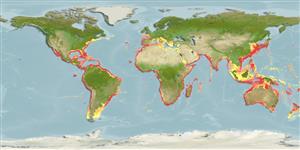Classificação / Names
Common names from other countries
Referência principal
Tamanho / Peso / Idade
Max length : 234 cm TL macho/indeterminado; (Ref. 26340); common length : 100.0 cm TL macho/indeterminado; (Ref. 26999); Peso máx. publicado: 5.0 kg (Ref. ); Idade máx. registada: 15 anos (Ref. 7142)
Length at first maturity
Lm 46.3, range 30 - 99 cm
Ambiente
; marinhas; estuarina bentopelágico; anfídromo (Ref. 51243); intervalo de profundidade 0 - 589 m (Ref. 58018), usually 100 - 350 m (Ref. 35388)
Clima / Intervalo
Subtropical, preferred 26°C (Ref. 107945); 49°N - 54°S, 114°W - 180°E (Ref. 54931)
Distribuição
Circumtropical and temperate waters of the world. Trichiurus japonicus which was originally described from Japan as Trichiurus lepturus japonicus was synonymized with Trichiurus lepturus. Another nominal species synonymized with Trichiurus lepturus is Trichiurus nitens from the eastern Pacific Ocean (California to Peru).
Países | Áreas FAO | Ecossistemas | Ocorrências | Introduções
Descrição breve
Espinhos dorsais (total): 3; Raios dorsais moles (total): 130-135; Raios anais moles: 100 - 105. Body extremely elongate, compressed and tapering to a point. Mouth large with a dermal process at the tip of each jaw. Dorsal fin relatively high; anal fin reduced to minute spinules usually embedded in the skin or slightly breaking through; anterior margin of pectoral fin spine not serrated. Pelvic and caudal fins absent. Lateral line beginning at the upper margin of the gill cover, running oblique to behind the tip of the pectoral fins, then straight close to the ventral contour. Fresh specimens steely blue with silvery reflections, becoming uniformly silvery gray sometime after death (Ref. 6181).
Categoria na Lista Vermelha da IUCN (Ref. 115185)
Ameaça para o homem
Harmless
Utilização humana
Pescarias: altamente comercial; peixe desportivo: sim
Ferramentas
Relatórios especiais
Descarregue XML
Fontes da internet
Estimates of some properties based on models
Phylogenetic diversity index
PD50 = 0.5020 many relatives (e.g. carps) 0.5 - 2.0 few relatives (e.g. lungfishes)
Nível Trófico
4.4 ±0.4 se; Based on diet studies.
Resiliência
Médio, tempo mínimo de duplicação da população 1,4 - 4,4 anos (K=0.25-0.29; tm=2; tmax=15)
Vulnerabilidade
Moderate to high vulnerability (51 of 100)
Categoria de preço
